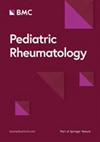Bone health and physical activity in adolescents with juvenile idiopathic arthritis: a cross-sectional case-control study
IF 2.8
3区 医学
Q1 PEDIATRICS
引用次数: 0
Abstract
Adolescents with juvenile idiopathic arthritis (JIA) tend to engage in less physical activity than their typically developing peers. Physical activity is essential for bone development and reduced physical activity may detrimentally effect bone health. Thus, we examined differences in total body bone mineral content (BMC) and areal bone mineral density (aBMD) between adolescents with JIA and adolescent controls without JIA. We also examined associations between moderate-to-vigorous physical activity (MVPA), lean mass, and bone outcomes. Participants included 21 adolescents with JIA (14 females, 7 males) and 21 sex- and age-matched controls aged 10–20 years. Assessments included: height; weight; triple-single-leg-hop distance (TSLH); MVPA by accelerometry; and total body BMC, aBMD, and lean mass measured using dual X-ray absorptiometry. Height-adjusted z-scores were calculated for BMC and aBMD and used for all analyses. Multiple linear mixed effects models examined group differences in BMC and aBMD, adjusting for sex, maturity, MVPA, TSLH, and lean mass. Participants clusters, based on sex and age (within 18 months), were considered random effects. Adolescents with JIA had lower total body aBMD z-scores [β (95% CI); -0.58 (-1.10 to -0.07), p = 0.03] and BMC z-scores [-0.47 (-0.91 to -0.03), p = 0.04] compared with controls. Mean daily MVPA was 22.0 min/day lower in adolescents with JIA than controls; however, MVPA was not associated with aBMD [-0.01 (-0.01 to 0.01), p = 0.32] or BMC [0.00 (-0.01 to 0.00), p = 0.39]. Lean mass was positively associated with aBMD [0.05 (0.01 to 0.09) g/cm2, p = 0.03] and BMC [0.06 (0.03 to 0.10) g, p < 0.001]. Adolescents with JIA had lower total body aBMD and BMC compared with sex- and age-matched controls without JIA. Group differences in bone outcomes were not associated with the lower MVPA participation of adolescents with JIA. Despite this, physical activity should still be encouraged as it promotes physical well-being.患有幼年特发性关节炎的青少年的骨骼健康和体育锻炼:一项横断面病例对照研究
与发育正常的同龄人相比,患有幼年特发性关节炎(JIA)的青少年往往运动量较少。体力活动对骨骼发育至关重要,减少体力活动可能会对骨骼健康造成不利影响。因此,我们研究了患有 JIA 的青少年与未患有 JIA 的青少年对照组在全身骨矿物质含量(BMC)和骨矿物质密度(aBMD)方面的差异。我们还研究了中到剧烈运动(MVPA)、瘦体重和骨骼结果之间的关联。参与者包括 21 名患有 JIA 的青少年(14 名女性,7 名男性)和 21 名性别和年龄匹配的 10-20 岁对照组青少年。评估项目包括:身高、体重、三单腿跳跃距离(TSLH)、加速度测量法测量的MVPA、双X射线吸收测量法测量的全身BMC、aBMD和瘦体重。在所有分析中,都计算了BMC和aBMD的身高调整z分数。多重线性混合效应模型检验了 BMC 和 aBMD 的组间差异,并对性别、成熟度、MVPA、TSLH 和瘦体重进行了调整。基于性别和年龄(18 个月以内)的参与者分组被视为随机效应。与对照组相比,患有 JIA 的青少年全身 aBMD z 评分较低 [β(95% CI);-0.58(-1.10 至 -0.07),p = 0.03],BMC z 评分较低 [-0.47(-0.91 至 -0.03),p = 0.04]。与对照组相比,JIA 青少年的平均每日 MVPA 低 22.0 分钟/天;但是,MVPA 与 aBMD [-0.01 (-0.01 to 0.01),p = 0.32] 或 BMC [0.00 (-0.01 to 0.00),p = 0.39] 无关。瘦体重与 aBMD [0.05 (0.01 to 0.09) g/cm2, p = 0.03] 和 BMC [0.06 (0.03 to 0.10) g, p < 0.001] 呈正相关。与无 JIA 的性别和年龄匹配对照组相比,患有 JIA 的青少年全身 aBMD 和 BMC 较低。骨骼结果的群体差异与患有 JIA 的青少年较少参加 MVPA 无关。尽管如此,仍应鼓励体育锻炼,因为体育锻炼能促进身体健康。
本文章由计算机程序翻译,如有差异,请以英文原文为准。
求助全文
约1分钟内获得全文
求助全文
来源期刊

Pediatric Rheumatology
PEDIATRICS-RHEUMATOLOGY
CiteScore
4.10
自引率
8.00%
发文量
95
审稿时长
>12 weeks
期刊介绍:
Pediatric Rheumatology is an open access, peer-reviewed, online journal encompassing all aspects of clinical and basic research related to pediatric rheumatology and allied subjects.
The journal’s scope of diseases and syndromes include musculoskeletal pain syndromes, rheumatic fever and post-streptococcal syndromes, juvenile idiopathic arthritis, systemic lupus erythematosus, juvenile dermatomyositis, local and systemic scleroderma, Kawasaki disease, Henoch-Schonlein purpura and other vasculitides, sarcoidosis, inherited musculoskeletal syndromes, autoinflammatory syndromes, and others.
 求助内容:
求助内容: 应助结果提醒方式:
应助结果提醒方式:


